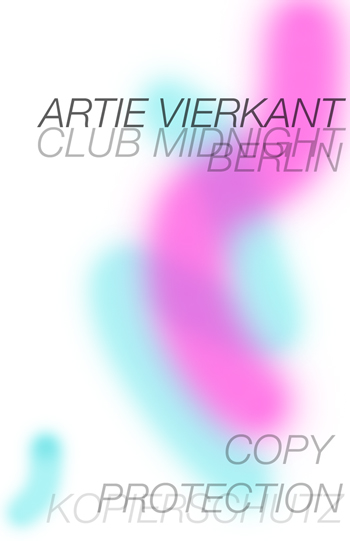ARTIE VIERKANT
Copy Protection / Kopierschutz
Opening: November 18, 2011 | 7 p.m
November 19 - January 15, 2012
hours: 3 - 8 pm | wednesday - saturday
Club Midnight: kurfurstenstrasse 35 - 10785, Berlin
www.clubmidnight.de | info@clubmidnight.de

The works in Copy Protection / Kopierschutz are intended to be shared.
It has become that the greatest cultural endeavor of our time—the orthodoxy we must work against—is not to facilitate the open sharing of information, but instead to generate methods which establish a scarcity for digital objects.
When a feature film is made, film distributors, festivals, and reviewers will often receive “screener” copies of the films on disc. Each of these copies, while deriving from the same source file—a digital file capable of being freely shared, altered, and copied an effectively infinite amount of times—will receive a specialized, unique digital watermark. These watermarks come in a variety of forms. Often they are visual: a visible arrangement of letters overlaid on top of the image, reading “PROPERTY OF _____________ DO NOT REDISTRIBUTE.” This is the simplest form of watermarking, harkening back to the origin of the term (in watermarking for official / legal documents on paper and other materials), though it offers the least defense (termed “robustness”—the relative difficulty it takes to remove a watermark from a source file). If handled properly, each pre-release copy of said film will be imprinted with a watermark in a different region of the frame, sometimes just barely different. If the film falls into “the wrong hands” and is later found for free download on bittorrent or another filesharing service, the location of the text or other marks will be used to determine the location the copy was originally sent to, and legal measures may be taken. That entity will certainly never be receiving a screener copy again.
Each copy of the screener will be created as a unique, impermeable object. The clear and publicly stated reason for this is to establish a degree of control over access to the information distributors of cultural materials wish to sell. Or, in the words of “content identification” corporation Mediahedge, “Digital Fingerprinting gives content owners and publishers more options to control the distribution of their content and enables monetization models.”1
The techniques employed by these groups exist specifically as a control method to limit the free transference of information. More than that, they and techniques like them impose an idea of scarcity onto objects which are inherently non-scarce.
As countless organizations spring up to work towards an idea of content control and digital scarcity, the cultural landscape of the Internet drifts slowly closer and closer to a model matching the pre-existing economy of rivalry which was the norm prior to the end of the 20th century. The most often cited reasoning towards this—other than pure economic banter about the impossibility of controlling digital marketplaces without scarcity—focuses on both preventing “illegitimate use”2 (not just distribution but any alterations and versions) and on assuring that the consumer receives the highest quality version of the content possible, “providing the best possible consumer experience.”3Rather than re-casting our relationship to objects, images, and other cultural materials in light of a radical change in our methods of creating and distributing them, every effort is being made to maintain the status quo.
Copy Protection / Kopierschutz presents a selection of objects which use culture-industry methodologies or materials towards different goals. Rather than marking, authenticating, and versioning for purposes of control, these objects are marked to facilitate their own proliferation, or presented as wholly inauthentic versions of themselves.
//
1Mediahedge, Digital Fingerprinting White Paper, (January 2010), http://www.mediahedge.com/fileadmin/bestanden/pdf/White_Paper_- _Digital_Fingerprinting_by_Mediahedge_01-2010.pdf
2Digital Watermarking Alliance, The Case for Content Identification: Supporting New Business Models and Effectively Managing Key Business Assets (June 2010)
3Digimarc, Digital Watermarking for the Digital Age: Empowering Consumers and Protecting Copyrights
Artie Vierkant Club Midnight, Berlin 19 Nov – 15 Jan 2011/2
